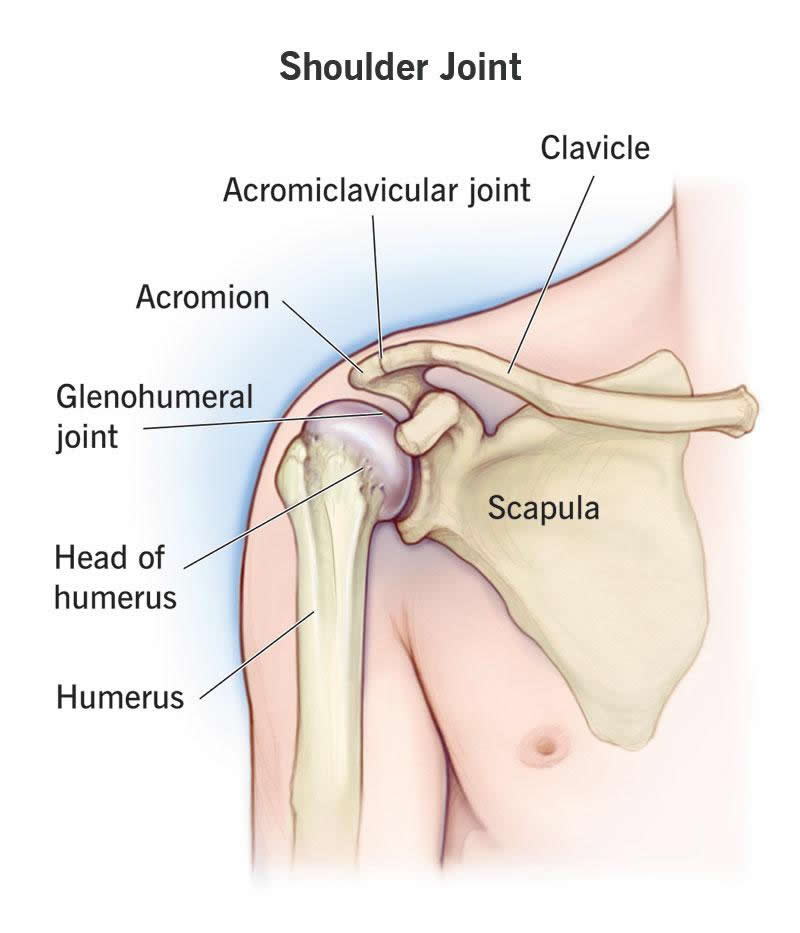Shoulder Joint
Your shoulder joint (glenohumeral joint) is a ball-and-socket joint that connects your upper arm bone (humerus) and shoulder blade (scapula). This lets you move and rotate your arms. It has the greatest range of motion of all the joints in your body.
What Is a Shoulder Joint?

Your shoulder joint (glenohumeral joint) is where your upper arm bone, shoulder blade and collarbone connect. A joint is a place where the ends of your bones meet.
Your shoulder is a ball-and-socket joint. That means the rounded end of your upper arm bone fits into a curve in your shoulder blade. It moves and spins in many directions. This gives it a greater range of motion than any other joint in your body.
Function
What does the shoulder joint do?
Your shoulder makes it possible for you to:
- Lift your arm in front of your body, like to shake someone’s hand or pick up a cup of coffee.
- Reach behind your back, like to put your coat on or scratch an itch.
- Raise and lower your arm, like to wave at someone or stretch your arms overhead.
- Rotate your arm, like to turn a faucet handle or throw a ball.
Anatomy
Where is your glenohumeral joint located?
The joint sits at the top of your arm at the point where your upper arm bone meets the top of your shoulder blade. Other parts of your body work with or support your glenohumeral joint, including your:
- Acromioclavicular or AC joint:This joint sits where your shoulder blade meets your collarbone. Unlike your free-wheeling shoulder joint, your AC joint stays put unless your shoulder muscles’ action makes it move. Your shoulder ligaments connect at this joint.
- Cartilage: This is strong, flexible tissue that lines the cup of your shoulder blade (glenoid labrum). More cartilage cushions the ends of bones that connect to your joint.
- Rotator cuff: This group of muscles and tendons holds and supports your shoulder. They help you turn and rotate your shoulder.
- Subacromial bursae: These are fluid-filled sacs that cushion your acromioclavicular joint.
- Synovial membrane: This membrane makes a slick fluid that surrounds your shoulder so it can move more easily.
Conditions and Disorders
What common conditions can affect your shoulder?
Anything that damages nearby bones, muscles or ligaments can hurt your shoulder, including conditions like:
- Dislocated shoulder:Healthcare providers may call this a glenohumeral joint dislocation. It happens when something forces the rounded end of your upper arm from its spot in the cup of your shoulder blade.
- Osteoarthritis:This is known as wear-and-tear arthritis. It develops over time when the cartilage lining your joint wears down, so your bones rub together.
- Shoulder bursitis:You may have this condition if something irritates the fluid-filled sacs in your shoulder. Symptoms are shoulder pain, swelling, stiffness and skin discoloration.
- Shoulder fracture:You can break the bones of the shoulder joint, including the ball, socket, shoulder blade or collarbone. Breaking your collarbone or shoulder blade can affect the position and movement of your glenohumeral joint. Breaking the ball or socket can cause pain and weakness with moving the joint.
- Shoulder sprain:This is when you stretch ligaments that support your shoulder. Symptoms are shoulder pain, swelling and bruising.
- Rotator cuff tendinitis or tearing:Doing the same movements repeatedly can put stress on your shoulder joint and make your rotator cuff swell or tear. Large tears of your rotator cuff can cause pain and weakness of your shoulder and arm.
Common symptoms of shoulder conditions
Several conditions can affect your glenohumeral joint. Some common symptoms include:
- Shoulder pain that can be moderate or severe. It can come on quickly or get worse over time.
- Swelling.
- Stiffness or weakness that makes it hard for you to move your shoulder or arm.
- Bruising or skin discoloration at the injury site.
Care
How can I keep my shoulder healthy?
Your shoulder joint works hard every day. The following suggestions can help keep it going strong:
- Eat well:Focus on foods that reduce inflammation, including fish and vegetables, like broccoli, cabbage and leafy greens. Inflammation in your joints can lead to osteoarthritis.
- Be active:Aerobic exercise, strength training and routines to improve flexibility can protect cartilage in your shoulder joint.
- Take care of your joints: Steps like quitting smoking, choosing water over soda or energy drinks, and maintaining a weight that’s right for you can help support joint health.
A note from Wockr
Your hard-working shoulder joint is why you can do things like share hugs, grab items from high shelves or throw a ball. You can keep your shoulder in working order by eating well and being active. Like all joints, this one can wear out over time. Talk to a healthcare provider if you have symptoms like shoulder pain and stiffness that don’t go away.